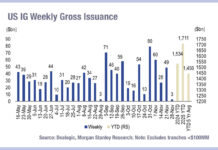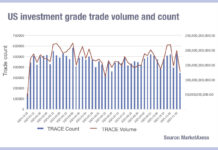Credit investors may see the relative calm in the market at present as a point at which to trade into safer positions, according to bank analysts.
Credit markets are seeing a tightening of spreads, thanks to a retrenchment of US economic policy, following the peak of early April. This lull is revealing gaps in expectations in credit, and potentially opportunities – depending upon one’s outlook.
While bid-ask spreads increased at the same time as spreads widened in US and European credit markets in early April, and both have declined since, there is still considerable uncertainty affecting credit conditions and therefore the costs associated with carrying risk as either market maker or investor.
Morgan Stanley analysts have observed that credit spreads are still below “long-term medians” and although the credit funds saw a sudden outflow of capital in April, across both active and passive bases, that has since calmed, with European ETFs seeing inflows returning.

Mohit Mittal, PIMCO’s CIO of Core Strategies, wrote in an April 2025 note to clients, “Since the end of January, the total returns of investment grade and high yield bonds have remained relatively stable, reinforcing our confidence in their resilience. In contrast, business development companies (BDCs), which invest in debt of private small- and mid-sized businesses and serve as a general indicator of less liquid private corporate credit markets, have seen significant declines. This drop highlights the negative impact of the current environment on the credit quality of the underlying holdings.”
Europe has seen weekly issuance in high yield and investment grade credit fall year-to-date (YTD) against the same period in 2024, while US investment grade is net up YTD against the same period in 2024, however April took a real hit. Although volatility slowed issuance for a period, it returned end of the month for highly-rated debt including financials. Morgan Stanley’s assessment of trailing three month flows for IG and HY across European and the US are negative.
“Issuers tapped debt markets during periods of stability and were met with strong demand,” the bank’s analysts observed. “New issue concessions, which rose intra-month, fell into May while subscription levels rose. YTD [US] IG supply is 5% higher YoY. Long-end issuance fell to just 5% of April supply.”
From a credit risk perspective there is still a much greater value of debt being upgraded than downgraded on risk, looking at the BAML ICE index. Some big names are negatively rated – with Boeing now on a negative rating across Fitch, Moody’s and S&P – but there is also an imbalance between the risk of a recession being priced into credit which MS estimates is priced as 10-25% chance, versus the view of economist which across banks are reaching 40—50% in some cases. Total fallen angel pipeline estimated to have hit US$255 billion in May, US$5 billion more than in April.
Bank of America’s latest Bull & Bear Indicator across asset classes is largely bearish, with credit technicals contributing a strongly bullish aspect, but bond flows being lightly bearish.
“We suggest investors use periods where spreads are close to the low-end of these ranges to reduce beta, improve liquidity, and rotate to defensive sectors,” said the Morgan Stanley analysts on US credit. “The sell-off in rates means the set-up for high grade credit is quite healthy. We like long-end and low USD bonds, and stick with our preference for Financials and Utilities as tariff insulated sectors. Cautious on Energy/Consumer.”
©Markets Media Europe 2025















